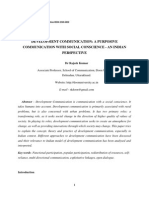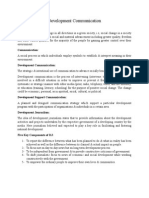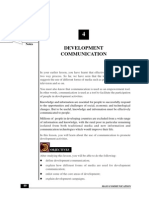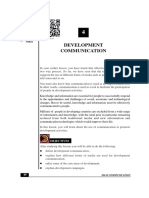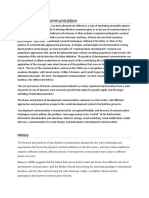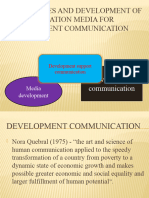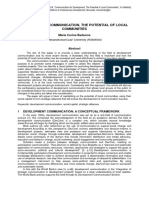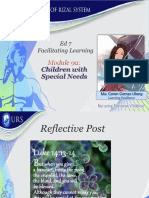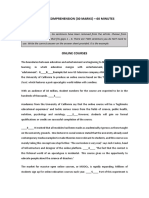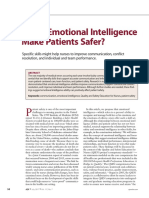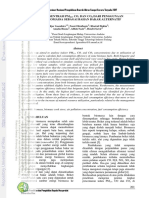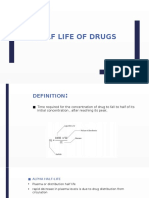APPROACHES TO DEVELOPMENT COMMUNICATION
INTRODUCTION
Development is perhaps one of the most fiercely debated concepts in the contemporary
social sciences. The it is often equated with ‘modernization’, ‘industrialization’, ‘social change’,
‘progress’ and ‘growth’, and like these other terms is invariably seen as something desirable and
positive for society in general, and for the community in particular. Development is seen as
absolute, inevitable, and universal; it is promoted as a laudable goal no matter what the society,
the culture, the people and their resources and traditions.
Development has been one of the ideals and aspirations of all human societies. It has an
inherent functional value in raising the socio-economic standard and the life style of the citizens
as it aims to provide basic needs to all, particularly the deprived sections of society. The supreme
aim of development should be to improve the quality of life for its citizens and to guarantee
social justice.
In general terms, development communication could be communication done through
various mediums to bring about some changes in the society or in other words changes leading to
socio-economic development of the society, achieved through communication. Communication
plays a central role in development.
WHAT IS DEVELOPMENT?
According to Dr. Adebayo Oyebade, (2001), development means simply the ability of a
nation to create a viable political and economic system capable of bringing growth and
advancement to a nation. This means sustainable democracy, effective bureaucracy,
accountability in public service, social justice and human rights, and a sound economy capable of
1
�providing better life for the great majority of the masses. Dissanayake (1981) defines
development as the process of social change which has as its goal the improvement in the quality
of life of all or the majority of the people without doing violence to the natural and cultural
environment in which they exist and which seeks to involve the generality of the people as
closely as possible in this enterprise, making them the masters of their own destiny.
OVERVIEW OF DEVELOPMENT COMMUNICATION
The focal point of development communication is the use of strategic communication
interventions to bring about social change. Akinfeleye (2008) expressed that communication is
the most effective means of meeting many of the burning issues of the society. The mass media
should relay ideas and information on development issues; they should present a representation
of the society in which they operate, they should be tools for attitude formation and attitude
change. “As tools of national development, the mass media should give representative and
unbiased and accurate picture of the goals, aspirations and socio-political foundation of the
society in which they operate”. They should relate the events that work to the advantage of the
society and present those that are to the disadvantage of the society. They should be powerful
tools for education and should serve as the “market place of ideas” for the populace.
J.F. Jamias articulated the philosophy of development communication, anchoring it on
three main ideas, namely purposive, value-laden and pragmatic; they have become the
philosophy that drives development communication. Prof Nora C. Quebral, a pioneer in
development communication in Asia, expanded Jamias’s philosophy and then referred to
development communication as, “The art and science of human communication linked to a
2
�society’s planned transformation from a state of poverty to one dynamic socio-economic growth
that makes for greater equality and the larger unfolding of individual potentials” (Quebral, 2001).
Davies 2004 opined that “Development communication is a participatory form of
communication in terms of content production and dissemination also known as ‘communication
for development’ (C4D) and is a people-centered communication utilizing both old and new
technologies to promote and elaborate on people’s own communication needs and aims”.
Development is very important in any society. Living a life of hardship when there are
opportunities for better quality of life makes life even more difficult. Communication is
however, important to facilitating positive change in any society.
According to UNICEF (2015), communication lies at the center of sustainable
development. Communication for development has to do with understanding people, their beliefs
and their values. It involves engaging communities to identify problems, offering solutions and
taking appropriate action. Development communication involves a wide range of activities;
examples of which are teaching women how to exclusively breastfeed their babies; working with
boys and men to prevent domestic violence, persuading parents and families to send their
daughters to school, persuading parents to present their children for immunization, disease
prevention, promotion of modern farm practices and getting parents to register the birth of their
children.
The approaches to Dev Com available to a Dev Com expert include the following;
INTERPERSONAL APPROACH:
The interpersonal approach of the dev com uses two methods which are:
3
�1. Extension and Community Development Method: This is the oldest method of
using communication to bring about development and it seeks to bring change
through its rural and participatory orientation (Kaul, 2011). The method is primarily
concerned with transfer of useful information to the different communities through
interpersonal face-to-face communication and educates them about effective ways of
doing businesses in sectors like agriculture and other farming related activities in
addition to bringing awareness among them on issues like health, sanitation,
education, economics etc.
It is accepted as an effective method to reach rural dwellers with development
messages as rural communities are interested in improving their living standard
through the new ideas and techniques which they find adaptable for themselves. This
method emphasizes on the fact that the communicator should be capable of
identifying the actual issues prevalent in a particular community and then should
develop ways to redress those issues by utilizing proper techniques of information
dissemination.
In India, this method of the interpersonal approach of development communication
has been used extensively by various non-profit organizations as well as government
and the international agencies working in various sectors like health, education,
agriculture, environmental conservation etc.
2. The Ideological and Mass Mobilization method: This approach is basically utilized
by the political organizations with different ideologies as it believes that issues could
be redressed and development could occur only with the change of political alignment
of the people living in different regions. As such, this method is exploited as a part of
4
� development communication to bring political awareness among the people or in
other terms in raising their political consciousness. Tanzania is one of such countries
in the world where this method is exercised by the major political parties in producing
and disseminating ideological messages to the people in rural communities for rural
development.
MASS MEDIA APPROACH
Like interpersonal approach, mass media approach uses two methods namely: Centralized
mass media method and localized mass media method, Kumar, 2011.
1. The centralized mass media: This method focuses on developing a media infrastructure
that has a centralized control hence controlling the flow and direction of media content
too. As such, this form of communication system, completely ignores the interpersonal
features of communication and depends completely on the mass media for the
dissemination of information. And due to its complete reliance on mass media, the
coverage of the issue is very general in nature.
In this method of communication, the media content is predominantly produced by the
experts usually in media organizations located in the urban centers with least interest in
involving the audience’s voice or suggestions of any form in any manner. This method is
criticized by many who feel that the method does not cater to the people of different
regions and cultures with different kinds of information needs and that the content
provided by the mass media is at times completely different from what it should be to
bring about a positive change in people’s lives.
5
� The localized mass media method: This approach borrows heavily from the Democratic-
participant Media theory of Dennis McQuail in 1983 that emphasizes on encouraging local
media channels that would involve local people and encourage them to participate in the
process of communication hence reflecting on their issues and challenges and striving to find
ways to address the issues.
The method advocates for setting up of the local newspapers, radio stations and television
stations in rural areas which would help in generating media content relevant for the local
public by identifying their problems and the root causes. The method encourages the local
journalists to directly get in touch with the people through meetings, discussions and phone
calls, and then incorporate their voices in the programmes, contents of the press and the
television and radio stations.
Scholars advocating this method believe that it creates opportunities for both the media
organizations and the masses to participate in the communication process and come together
to plan and produce messages which could lead the socio-economic and cultural development
of the rural communities.
INTEGRATION APPROACH
Looking at the limitations and potentials of both interpersonal and mass media approaches to
development communication, many scholars felt that there could be ways in which both the
approaches could be blended together to avoid the limitations and capitalize the potentials (Imoh,
2013).
This approach incorporates in itself the interpersonal elements like extension and community
development method as well as the ideological and mass mobilization method, while at the same
6
�time it also takes advantage of mass media approach to include the components of centralized
and localized communication methods (Baba J. J., 2015). And all these methods are combined
together to develop new communication channels like street plays, village drama, musical
programmes, theatres etc, aimed at spreading messages among the masses with a traditional
appeal which could result in development by bringing about some behavioral and attitudinal
changes in the community. Such acts of information dissemination not only entertain the
audience but also sends some strong messages that serve as platforms for improving their living
standards and quality of life through education and awareness. The aim of such channels is to
facilitate networks which encourage discussions among the stakeholders of the development.
DIFFUSION/EXTENSION APPROACH
The main focus of this approach is the adoption of technological and social innovations
through diffusion of new ideas, services and products. Diffusion of both material and social
innovations is necessary for development. Material innovations refer to economic and
technological innovations and social innovations pertain to social needs and structure.
PROCESS OF DIFFUSION
1. The process of diffusion starts with the need of individual and community decisions for
acceptance and rejection of innovations, which depends primarily on the needs of the
adopters.
2. The resultant consequences of diffusion can be direct/indirect, latent/manifest, and
functional/dysfunctional.
3. The early models of diffusion focused only on material growth. But it was soon realized
that social growth along with material growth was necessary for diffusion of products,
7
� ideas and services. Therefore, diffusion decisions have to handle the economic,
technological and social constraints
Israel (2018) further identified and explains three main approaches to development, which were
adopted in 1990 by the United Nations Development Programme (UNDP) as a basis for the
measurement of human development index (HDI).
THE WELFARE APPROACH
The welfare approach is one of the earliest approaches to development. It considers
development a “public product”, basing its considerations on factors such as education and
health and other services that should be supplied to the people by government and non-profit
organisations. Money and activities are mainly channeled towards supplying the people with
welfare to reduce poverty and enhance development. This approach does not pay attention to
entities such as political and economic relationships and conditions that hinder the people from
taking advantage of the assistance offered them.
THE RIGHTS APPROACH
This approach relates with human rights. It is based on the reasoning that people should be
empowered or reinforced to make them capable of requesting development, taking advantage of
the assistance given them, on the one hand; and on the other hand, government agencies should
be strengthened to enable them identify the people’s needs (which are like rights) and satisfy
those needs. The government should provide services to the people, transform the society and
enable the people to be self-sufficient.
8
� THE SUSTAINABILITY APPROACH
This is also known as the self-sustaining development approach. This approach began in the
1970s and it received impetus when the United Nations (UN) published the Brundtl and Report
in 1987. The approach does something differently by relating development to all the countries in
the world and not limiting it to developing countries. As testimonies about the influence of
industrialization and modernization grew, this resulted in the growth of the support for
sustainable development, which relates to the needs of both the present and future generations in
a way that reflects equality, and demands that the environmental influences of economic growth
be taken into the planning process. However, the demand for sustainable development in
developing countries is limited, as this kind of development requires wider economic investment
in long term processes which developing countries, on principle, request that they be not required
to do.
DEVELPOMNT COMMUNICATION PROJECT AND THR APROACH TO ADOPT
RURAL POVERTY
Rural Poverty continues to increase in many countries, accelerating urban migration and
creating intolerable economic and social problems. The solution, of course, lies in the
development of rural areas. Most rural communities are characterized by reliance on traditional
knowledge and production systems, based strictly on what has worked for survival in the past.
This has led to a view that rural communities are resistant to change, even though their
traditional wisdom has been hard-won and its reasoning is sound. Dev Com planners need to take
9
�this into account, as the first step of any planning exercise. For this, and for all rural development
activities, communication between local communities and national planners and policy-makers is
of vital importance but, unfortunately, in rural areas it is at its weakest.
In order to bring about sustainable development in a rural community in Nigeria, the
Extension and Community Development Method of the Inter Personal Approach will be adopted.
According to Kalu 2011, this approach is the oldest method of using communication to bring
about development and it seeks to bring change through its rural and participatory orientation.
The method is primarily concerned with transfer of useful information to the different
communities through interpersonal face-to-face communication and educates them about
effective ways of doing businesses in sectors like agriculture and other farming related activities
in addition to bringing awareness among them on issues like health, sanitation, education,
economics etc.
The Extension and Community Development approach is going to be adopted because;
1. It entails face-to-face communication which is the most effective way to communicate to
rural dwellers due to language barrier, lack of access to modern media of communication,
or illiteracy.
2. It helps people at this levels to communicate, thus empowers them to recognize important
issues and find common grounds for action, and builds a sense of identity and
participation in order to implement their decisions.
3. This approach enables project beneficiaries to become the principal actors to make
development programmes successful.
4. Any development programme that regards people as mere recipients, rather than as the
actual creators of change and progress, usually fails. Consulting the people and actively
10
� involving them in making the decisions that will affect them and ensures the programme's
success.
5. As active participant in their development process, they will be anxious for fast execution
of the project and therefore do everything within their power to speed up the process, thus
leading to a successful result that will be sustainable in the long run.
6. Active participation encourage adoption of those new ideas and methods, and improve
training.
7. This approach will also help to convert deviants as information about the develo0ment
programme will not only reach them through the Dev Com expert, but participants from
their community who the trust.
Conclusion
Development communication is not merely concerned with disseminating information on
development activities. Besides informing and educating the people on the technical nature
of new ideas and on how they work and with what effect, development communication plays
the more important role of creating an atmosphere for understanding how these new ideas fit
into the real social situation in which the people operate.
Its ultimate goal is to serve as a catalyst for local development activities, planning and
implementation, and local communication acts as the grease to smoothen the path to
development. If development communication must succeed, then it must include strong
components of social organization and interpersonal as well as traditional modes and media.
In addition, Dev Com experts in charge of planning development communication must
understand the local socio-cultural environment and how change can take place in it- not
merely how development messages can be disseminated.
11
�REFERENCES
1. Adebayo Oyebade, 2001, May 5. Issues of Development in Nigeria. Annual Lecture
Series of the Association of Nigerians in the capital district of the state of New York,
seminar held at the Schacht Fine Arts Center, Sage College, Troy, NY Retrieved 11
October 2021 from
http://niilmuniversity.in/coursepack/media/Development_Communication.pdf
2. Akinfeleye, R. (2008). “Media Policy: Tool for National Development” In: Akinfeleye.
(2008). (ed). Contemporary Issues in Mass Media for Development and National Security.
Lagos: Malthouse Press Limited.
3. Andrew, A. M. (1991) Perspective on Development Communication edited by Kwame.
Accessed 11 October 2021 from
http://courseware.cutm.ac.in/wp-content/uploads/2020/05/Approaches-to-Development-
Communication.pdf
4. Baba, J. J. (2015, February 8). Dominant Paradigm of Development.
Accessed 12 October 2021 from
http://wecommunication.blogspot.in/2015/02/dominantparadigm-of-development.html
5. Davies, J. (2004). C4D 'Communicatoin for Development' Concept. The One World
Network. Accessed on 11 October 2021 from http://www.gjstx-e.cn/gallery/47-
june2020.pdf
6. Imoh, G. O. (2013). Application of Development Communication in Africa's Rural
Development - Need for a Paradigm Shift. Global Journal of Arts Humanities and Social
Sciences, 15-33.
12
�7. Kumar, R. (2011). Development Communication: A Purposive Communication with
Social Conscience - An Indian Perspective. Global Media Journal, 1-21. Accessed on 11
October 2021 from http://www.gjstx-e.cn/gallery/47-june2020.pdf
8. Quebral, N. (2001). “Development Communication in a Borderless World” Paper
presented at the National Conference Workshop on the Undergraduate Development
Communication Curriculum, “New Dimension, Bold Decisions” Continuing Education
Centre, UP LOS Barios, Dept of Science Communication, College of Philippines, Los
Banos. Accessed: 14 October 20212021 From www.wikipedia.org/Development-
communication #cite-note-4.
9. Unicef (2015) Communication for Development. Accessed 14 October 2021 from
https://www.unicef.org/cbsc/
13
